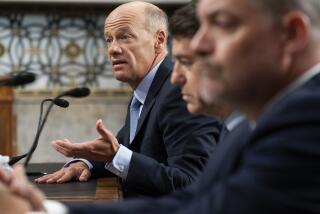Bush Wants Leader of S&L; Bailout to Quit
- Share via
WASHINGTON — The White House suggested Tuesday that the man in charge of the massive savings and loan cleanup should quit, but L. William Seidman refused to be pushed out the door before he is ready to go.
Angered by Seidman’s frequent private and public comments that the bailout cost is rising, the White House made it clear that it wants a resignation before Seidman’s term on the Resolution Trust Corp. is up in October, 1991.
President Bush has not formally asked Seidman to leave, but “we are interested in getting new leadership there that will carry out an aggressive program . . . “ White House Press Secretary Marlin Fitzwater said Tuesday.
A spokeswoman for the Resolution Trust chairman said that he “is going to stay until he feels things are moving in the right direction.”
Despite a flurry of pointed leaks from Administration officials, Seidman isn’t taking hints that he depart.
“Nothing is changed, the status is still quo,” said Carol Austrian, the spokeswoman for Seidman, who was in his hometown of Grand Rapids, Mich., Tuesday being inducted into the local business hall of fame.
Seidman himself has said before that he does not intend to stay until the end of his six-year term in 1991. However, he is determined to make substantial progress on the daunting task of closing hundreds of defunct thrifts and disposing of their assets--a job given him after the passage of the S&L; cleanup legislation last August.
Seidman, a proud man who made his fortune in the accounting business, wants to see the S&L; cleanup running smoothly before he leaves government service. He enjoys high respect in Congress and has been stubbornly independent of the Bush Administration.
He also serves as chairman of the Federal Deposit Insurance Corp., the guarantor of bank deposits. The Resolution Trust Corp. is an independent agency and he was confirmed by the Senate. The President can dismiss a Cabinet officer or other members of the executive branch, but he cannot fire the heads of independent agencies because of policy disagreements. They can only be fired for gross violations of federal laws or regulations.
The White House became particularly displeased after Seidman told the President in April that the bill for closing S&Ls; and paying off depositors was rising inexorably.
Current estimates offered by officials at the General Accounting Office and other experts range up to $500 billion during the next 30 years. Most of the money will pay for interest on bonds the government will sell to raise cash to pay off S&L; depositors. The ultimate cost will depend on the number of failing S&Ls; that are seized by the government and on the money the government recovers from selling the real estate holdings of these S&Ls--office; buildings, land, houses and apartments and other properties.
The Bush Administration is conducting its own review of potential costs and seems unlikely to come up with numbers that are significantly more optimistic than the gloomy counts offered by the GAO and other experts. However, the White House and Treasury are miffed by Seidman because his frankness with both Congress and the press sometimes has been embarrassingly at odds with official Administration policy.
The pace of the thrift cleanup has been slow, but Seidman announced a major policy shift on March 21, promising an accelerated schedule to sell or close 350 S&Ls; by year’s end, 140 of them by the end of June.
His agency also plans the biggest one-time real estate auction in history later this year, when the government will try to sell $200 million worth of property from seized S&Ls;, including office buildings, shopping centers, condominiums and raw land.
While the auction is of historic size, it represents only a tiny part of the government’s total inventory of real estate assets, which may reach $200 billion, depending on the final count of failed thrifts.
Seidman promised in his March announcement that he would close 52 of the weakest S&Ls; in Operation Clean Sweep and pay off depositors, whose accounts are insured by the federal government for as much as $100,000.
With these ambitious plans barely under way, Seidman has made it clear that he has no intention of departing suddenly and throwing the S&L; rescue into a new period of confusion and uncertainty.
“Seidman himself is the one who has said publicly that he intends to leave,” said White House spokesman Fitzwater. “And so I know there have been a lot of discussions about a replacement for him when the time comes.” In Washington, words like that are the equivalent of an invitation to depart immediately.
But Seidman wants to leave on his own schedule. His supporters in Congress agree. Two members of the House Banking, Finance and Urban Affairs Committee, Reps. Bruce F. Vento (D-Minn.) and Charles E. Schumer (D-N.Y.) quickly gathered 40 signatures on a letter to President Bush in support of Seidman. “I realize there are problems with the bailout but you do not solve it by shooting the messenger,” Vento said in an interview Tuesday.
More to Read
Inside the business of entertainment
The Wide Shot brings you news, analysis and insights on everything from streaming wars to production — and what it all means for the future.
You may occasionally receive promotional content from the Los Angeles Times.










